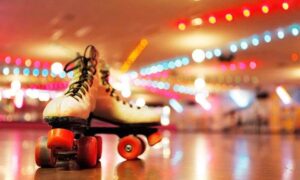
Roller-skating has become a popular pastime since the start of the pandemic. You can find clips of people roller-skating everywhere on social media, gliding smoothly down a sidewalk or in circles on a tennis court.
Many people, inspired by videos flooding TikTok and Instagram, bought roller skates in hopes of becoming somewhat skilled skaters.
Novice skater Willis Charlemond said, “I went to the skating rink as much as any other kid did growing up. Back to school, end-of-the year bashes, the occasional birthday party. It was not until we went on lockdown and I saw people on social media learning how to skate that made me want to learn.”
Today, if you go to an adult night at Skate World in Tallahassee, you will see a primarily Black crowd of locals and college students including some from FAMU. Black people have influenced roller skating culture by developing different skating styles and making roller skating a momentous event that showcased skating styles and techniques in this subculture’s unique fashion and music. It is crucial to understand the Black community’s influence in roller skating history and the role that roller-skating played in the civil rights movement.
Self-taught skater Richard Humphrey has been rolling and sliding for more than 45 years. Humphrey started skating at 5 years old but did not discover his passion for the sport until he was about 19 years old.
“I was attracted to the fun of it,” Humphrey said. “There were no social media around to show someone skate culture, you learned it by whatever you saw other people doing in your neighborhood, or the local rink.”
As the number of roller skaters grows Humphrey wants to make sure the new generation of skaters knows the deep-rooted history that is skate culture.
Along with public schools and amusement parks, roller rinks were among the most challenging places to desegregate. In an article written by an Indiana University student, Alex Petit, Black people were only allowed to go to the rinks on certain nights, “Black Night.” Over time, the roller rinks stopped referring to the nights as “Black Night” but became “soul night” or some other variation.
“A lot of people don’t know the history. That’s why they say roller skating is making a comeback, but it never left,” Humphrey said
According to Humphrey, before 1979, most people skated inside because their wheels needed smooth surfaces to function correctly. “The wheel changed everything,” Said Humphrey.
When the polyurethane wheel came out, people began to skate outside more because their wheels could handle bumps and cracks. “You could do more outside than you could in the rink because there were no rules outside. I’ve been to some rinks that don’t even allow you to skate backward,” Humphrey added.
Skating outside allowed people the freedom to master their roller-skating skills and develop their style of skating that influenced roller-skating culture still to this day.
“We got that bounce; we got that rhythm. It’s no doubt that Black culture influenced roller skating,” Humphrey said.
Humphrey refers to his signature style as “roller dance,” where you incorporate choreography and roller-skating.
Skating culture thrived in the Black community regardless of the continued segregation. Black skaters could groove and glide to the music they chose. People skate differently depending on where you live in the country. The HBO documentary “United Skates” depicted how skating varies from region to region.
The Chicago style, JB or James Brown, is where skaters focus on smooth footwork while rolling to James Brown mixes. In New York, people skate in trains of three to five people, and Philadelphia skaters like to skate backward at fast speeds.
Here at Skate World, you will see different skate styles.
Hip-hop music began in roller rinks, where artists like Ice Cube, Kurtis Blow, and Salt-N-Pepa started their music careers. When rap music first came out, the industry was ignored and not allowed on most media platforms. But, according to a Salt-N-Pepa interview in the “United Skates” documentary, roller rinks were one of the only places that hip-hop artists could perform, and many went on tours to different roller rinks to reach larger crowds.
Another skater new to the scene, Nikole Thompkins, said, “I always knew Black people had some kind of an influence on roller skating culture after watching roll bounce it’s impossible not to know, but I did not know that skating played such a huge role in the civil rights movement. I always thought skating came out in the 1970s.”
The recent burst in popularity has created a high demand for roller skates. Black-owned skate shops around the country have reported an increase in sales since the beginning of the pandemic. Companies like Moonlight Roller, Paradise and SK8 Fanatics are all meeting the high demand for skates.
Adrienne Cooper, Moonlight Roller owner, had plans to open an 18-and -older roller rink. However, when the pandemic hit, she changed plans and started selling what were going to be Moonlight rental skates. Since then, she has sold more than 3,000 pairs of skates and started her roller skate line, according to an article published by Melissa Santoyo on inc.com.
R&B duo Silk Sonic recently released a song titled “Skate” with a music video to match the song’s theme. In the video, group members Bruno Mars and Anderson Paak plays the drums while backed up by their band singing, “I’m trynna roll, I’m trynna ride,” as a group of women skate around them. The song’s nostalgic, feel-good vibe and catchy lyrics are described as “Summertime Jam” and are true to inspire more people to get out there and skate.